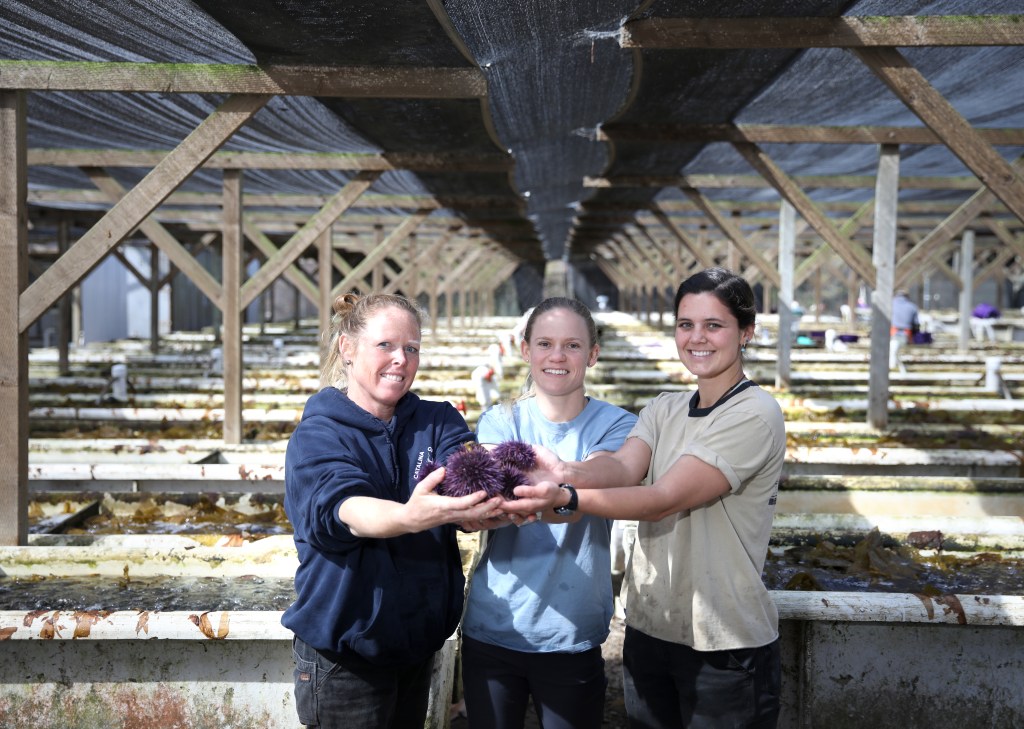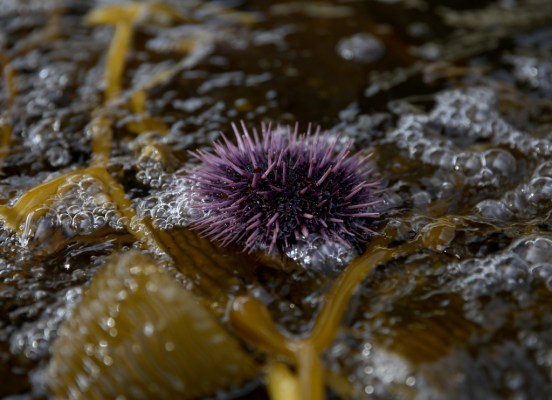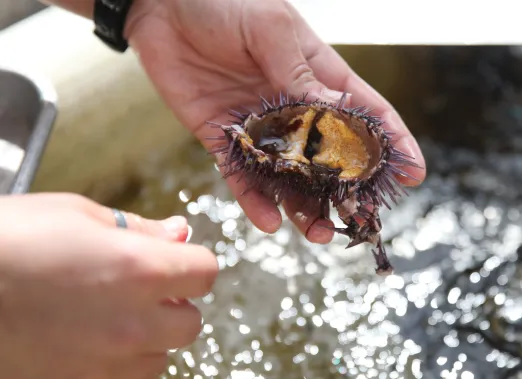Purple Urchin Possibilities
Santa Barbara Fishermen Team with Shellfish Farmer
to Build New Industry, Help Kelp Forests
By Matt Kettmann| Photos by Daniel Dreifuss | February 25, 2021

For a spiny creature that was quite alien to most California seafood lovers just a few years ago, the orange-fleshed gonads of urchin were being slurped at superspeed outside of the Sea Stephanie Fish booth on a sunny Saturday morning in October 2019. As thousands meandered around the docks, tasting through the Santa Barbara Harbor Festival, we could barely keep up with the fierce carapace cracking and delicate extraction of the soft, slippery meat to satisfy the wide demographic of uni fanatics.
Sea Stephanie Fish is the commercial fishing company owned by Harry Liquornik and Stephanie Mutz, the celebrated Santa Barbara urchin diver and global uni ambassador. I’ve known Mutz for years, and she’d invited my then-9-year-old son to shuck uni at that year’s fest, qualifying as his first paid gig ever. Given the apparent need for extra hands, I joined in as well, volunteering my amateur urchin-unleashing services to keep up with the constant demand. (It’s not difficult work, but prepare for a couple of days of red-stained hands.)
As far as I knew, the only items on the menu were the red urchins that thrive on the rocky edges of the Santa Barbara Channel, considered the best source for uni on the planet. But every so often, someone would sneak up toward the front of the line and inquire in hushed tones whether there were any purple urchins left. The “hotchis” had already sold out, Mutz would reply to their frowns, speaking in some secret seafood code.
I’m pretty good about staying on top of culinary curiosities, especially in my own backyard, but I’d never heard of hotchis, and didn’t know that California’s purple urchins could be eaten like the reds. As Mutz quickly educated me in her matter-of-fact manner, this smaller urchin species — only about two inches wide compared to the reds’ five-inch breadth — had only recently become an available uni option. And that was all due to a groundbreaking commercial-fishing-meets-aquaculture partnership that she and Liquornik launched with Doug Bush of The Cultured Abalone, an onshore shellfish farm on the Gaviota Coast.
Unlike most commercially caught seafood, which goes straight from the boat to the market, Mutz and Liquornik were harvesting purple urchins and delivering them to Bush to fatten in the same tanks — and on the same fresh seaweed — that he feeds his abalone. It wasn’t the first time someone thought about fattening purples or any of the other common urchin species around the world, whose smaller frames lack the consistently plump gonads as the reds. But as far as anyone can tell, this is the first time that the idea is actually creating a viable market — even through the pandemic, the supply can’t quite keep up with the demand.
If the project continues to prosper, the benefits are bountiful. For uni lovers, the purples, once properly fattened, are considered even sweeter and creamier than the reds.
For the traditionally competitive commercial fishing and aquaculture industries — where creative partnerships could be fighting food insecurity and ecological imbalance in the face of overpopulation and climate change — it’s a strong symbol of hope. “This idea that fishing and aquaculture are somehow adversarial is absolute nonsense,” Bush explained to me during a phone call last week. “This project highlights that fishing and aquaculture should be a collaborative part of the local seafood economy.”
And for those concerned about the health of oceans, eating purple urchins offers the opportunity to play a role — however miniscule — in culling the species’ currently problematic population densities and restoring kelp along the California coastline. As ocean waters warmed in recent years and urchin-grubbing sea stars were taken to near-extinction by disease, the purples have expanded their range and voracity, eating kelp forests clean and creating lifeless barrens like no one has ever seen.
“People want to feel like their seafood is engaged with a larger context, and the hotchis represent that,” said Bush. “You’d have to eat a lot, a lot, a lot of purple urchins to create a positive impact on the impact that the urchin barrens are having on the kelp biomass. On the other hand, these are natural cycles that get out of balance, and harvesting these purple urchins and commodifying them is just another tool in the toolbox.”
For Mutz, the project goes beyond anything she’s done in an already illustrious career to popularize uni and uplift the Santa Barbara fishing community. “Let’s make this a win-win-win,” she said. “Economically, ecologically, and socially — a triple bottom line.”
Scary Science

The interconnectedness of nature is rarely laid so bare as it is in the ocean’s intertidal zone, a biologically dense arena where land meets sea in shallow waters. Today’s proliferating purple urchins are the direct result of failing relationships between predator and prey, with the warming waters of climate change powering the mess.
“Southern California has always had alternating ecosystems,” explained Jenn Caselle, a research biologist at UCSB’s Marine Science Institute. “We have gone from a kelp-forested state to an urchin-barren state and then back again at some frequency. But now, especially since 2015, we’ve really been in a persistent state of warm water. It seems like that’s shocked the system into a persistent state of urchins. Barrens are now in places that they never used to be.”
Mutz agrees. “They’ve always been here,” she explained. “They’re not invasive — they’re just causing a nuisance at the moment.”
These warm waters likely contributed to sea star wasting disease, which has decimated populations of sea stars from British Columbia to Baja California. “It’s actually the biggest marine mass die-off that’s ever been recorded,” said Caselle.
When it comes to urchins, one of their top predators was the sunflower sea star, or Pycnopodia helianthoides, a massive, multi-armed, meter-wide beast that could usually be found prowling urchin barrens. “They just mowed them,” said Mutz. But the wasting disease made them “functionally extinct,” said Caselle, whose team hasn’t spotted one since 2014. “I have trained a whole new fleet of divers that have only seen them in pictures,” said Caselle. “That is scary stuff.”
It’s not just the kelp that’s harmed by the purple proliferation. “They affect everything,” said Caselle. “It’s a low-diversity, low-productivity system once you’ve got an urchin barren. Even the urchins don’t have anything to eat.” That’s a primary reason these seafloor-clearing purple urchins don’t usually have hearty gonads that humans want to eat — they’re starving on these barrens but can survive for literally years without eating.
Luckily for Southern California waters, Pycnopodia is not the only urchin predator. Both the Pacific spiny lobster and California sheepshead do a number on urchins. “The lobster and sheepshead, to some extent, are able to compensate for the loss of the sea star,” said Caselle, but she notes that both are also heavily fished by human predators. “Now you are putting pressure on your backups.”
Northern California hasn’t been so fortunate — neither lobsters nor sheephead venture much past the Monterey Bay. Purple urchins weren’t a problem in the past, due to the sea stars and historically large populations of sea otters, which were taken to near extinction by hunting a century ago. But with stars suddenly gone and otter numbers still a fraction of what they once were, the recent urchin impacts have been nothing short of disastrous, with kelp forests, red urchin, and abalone populations utterly decimated.
“On the North Coast, they didn’t have any backup,” said Caselle. “It’s hundreds of miles of urchin barrens now and no kelp whatsoever.” What are they doing about it? “Crying,” said Caselle, and she wasn’t kidding.
Urchin and abalone divers across the West Coast are partnering with ecology-minded organizations to smash and otherwise remove purples, but the human ability to counteract the issue is limited. “You’re never gonna smash all the urchins on the North Coast, but having people do something is important,” said Caselle. “They just need to be very clear on the expectations.”
Caselle is also very clear that we’re never going to eat the purple urchins back into balance. “Once these purples take over, you aren’t really gonna bring in 50 million of them,” said Caselle. “It’s just not scalable.”
The biggest hope right now is that nature itself fights back, whether in the form of cooler waters returning or perhaps something more drastic. “When urchins get that abundance,” said Caselle, “they’re known to have their own disease that comes through and wipes them out.”
Fun on the Fish Farm

I didn’t get to try any of the sold-out hotchis that day of the Harbor Fest, so in February 2020, I drove up to The Cultured Abalone fish farm to get my first taste and learn more from the whole team about their project firsthand. As the four of us stood on the edge of endless rows of what look like long, industrial-sized bathtubs — all gurgling away, with flashes of seaweed floating by — Mutz sorted through the purple urchins in the closest tank, pulled a few out, and began cutting them open.
Inside were uniformly sized gonads that came out with ease, at least compared to the sloppy scooping I recall from the Harbor Fest. Mutz cracked a bottle of Whitcraft chardonnay, and I plopped the meat into my mouth. Just like red urchins, they taste of the sea — briny, fresh, a bit kelpy. But the purples seemed a tad sweeter, their flesh more resilient yet still creamy in texture, the overall eating experience more compact and refined.
Chefs think so too. “The purple urchin are definitely sweeter,” said Jeff Olsson of Industrial Eats in Buellton. “They look very delicate in the little shells.” But Olsson is most fired up on how eating the hotchis are helping decrease their numbers, and that’s why Daisy Ryan of Bell’s in Los Alamos is a fan. “By eating them, you are helping the ocean’s ecosystem,” she said.
In nature, Liquornik explained as we stood under the shade cloth, finishing our wine, only about 1 in 20 purple urchins have enough meat for humans to eat, since they’re living on those barrens. But once they are fattened in these tanks over 10 to 12 weeks on four types of fresh seaweed — “it was important for us not to use synthetic food,” said Mutz — as many as 19 in 20 have marketable gonads. “We get great yield and extraordinarily consistent flavors,” confirmed Mutz.
“We were genuinely surprised to find out how quickly they fatted up and how delicious they were,” said Bush. “The first couple batches, everyone had the same reaction. ‘Oh my god, we might really be onto something. These are incredible!’”
As to calling the purple urchin a “hotchi,” the team researched a number of potentially marketable nicknames, learning that the Spanish word “erizo” meant both “urchin” and “hedgehog.” That led to the English Romani word “hotchi-witchi,” which means hedgehog but translates directly to “forest urchin.” “Hotchi” caught on quickly.
“Our biggest challenge right now is that we have marketed ourselves too well,” Mutz told me back in 2020, just before COVID-19 came to town. She’d been popularizing the new seafood with chefs in San Francisco, Los Angeles, Portland, and even New York, not to mention hosting hotchi-showcase dinners at places like Bibi Ji in Santa Barbara.
“We got a little ahead of ourselves,” admitted Bush around that same time. “People started ordering by the hundred, and we ran out real quick. Now we have a feel for it. The flow is moving together. We’ve got the basics down. Now we’re refining things.”
The pandemic hasn’t really affected anything. “Purple urchin project is full speed ahead,” Mutz emailed me in August. “Demand is high.” Just this month, she sang that same tune. “Not much has changed on our end, except demand is up!” wrote Mutz, who shifted her target market from restaurant to retail but is starting to prioritize restaurants again. “We have succeeded in 2020 because we are diversified with our markets.”
Abs & Urchins

As is clear from the farm’s name, urchins aren’t the main game at The Cultured Abalone. Bush considers the hotchis a pilot project, in which the supplies are being maintained while they figure out logistics and economics. The urchins occupy just a handful of the farm’s 400 tanks, which are dominated by one million abalone in various stages of development. That alone makes The Cultured Abalone a rarity in California, one of only three remaining abalone farms in a state that’s had an accelerate/hit-the-brakes relationship with aquaculture for decades.
“This was the golden age of the California Department of Fish and Game supporting aquaculture,” said Bush of when the state permitted more than 30 abalone farms in the 1980s, when the initial idea for what became The Cultured Abalone was envisioned by founders Dick Craig and Ben Beede. “But they got whittled away because abalone farming is hard.”
The most recent closure was The Abalone Farm in Cayucos, once a very popular and seemingly successful operation. “I am not happy that they’re gone,” said Bush. “I’m getting a lot of calls, but I liked having more of us.” The other two are the Monterey Abalone Company, which grows the shellfish in cages beneath a harbor, and American Abalone Farm in Davenport north of Santa Cruz, which recently underwent ownership and management changes.
The Cultured Abalone was officially launched on Dos Pueblos Ranch in 1995. After learning about aquaculture during his Peace Corps assignment in Malawi, getting a master’s in animal science from UC Davis, and working on projects from San Diego to Bodega Bay, Bush was lured to the company in 2004. Eight years later, he took over The Cultured Abalone with the help of his late business partner, David Albaum, who died in 2018.
“We turned this place around and kept it going,” said Bush. “The abalone business is challenging. They’re three to four years old when we sell them. Anything that takes that long to get to market size, there is just a huge amount of risk. There is so much that can go wrong, so much that can happen between spawning them and selling them.”
The economics aren’t easy, either. “It’s not very easy to respond to market pressures,” said Bush. “If demand is really good? Let’s grow more. They’ll be ready in four years.”
Yet abalone does pay the bills, and it’s even done okay during COVID-19, in part because The Cultured Abalone started selling directly to consumers when the restaurant business evaporated overnight. “That took a little of the edge off of the darkness,” he said of the direct-to-consumer shift, while hoping that restaurants really come back this summer. “Things are still highly fluid. We relied on consistency. That consistency is no longer there. Every week is different.”
Pandemics aside, Bush always saw the farm as a “whiteboard of creativity,” a prime place for experimentation and collaboration. “The abalone is kind of set; it’s got traction,” explained Bush, who also sells some culinary kelp as well. “But we’ve always felt that there was a huge value in this place just from the opportunity that it creates. California is such an embarrassment of riches with respect to marine resources, full of things that can be eaten or used for some type of market application. There is so much that can be done here.”
It’s not the first time anyone’s considered farming wild-caught urchins, and this trio even tried fattening red urchins a few years back but were not successful. They’ve known each other for years, and Mutz and Liquornik often work on Bush’s intake valves, which suck in 2,000 gallons of water per minute. “We get on real well,” said Bush. “We’ve had plenty of opportunities over the years to stand around the commercial pier and jaw about things.” The idea to do purples came up from those dockside conversations, just as the urchin barrens became more of a problem around the Santa Barbara Channel.
A much larger outfit called Urchinomics is working on a similar idea, but across the globe, pledging to pay fishermen to harvest urchins and develop a commercial market while funding kelp restoration. According to Denise MacDonald, who is in charge of global brand marketing for Urchinomics, the company’s successful pilot project in Japan is moving toward a full commercial buildout, and a facility in Newfoundland just finished a round of urchins to test the markets in Toronto and then New York.
In California, they’ve signed a lease for a commercial site in Bodega Bay, have worked on trials with UC San Diego and UC Davis, and have an ongoing partnership with the Bay Foundation in Santa Monica. “We are exploring other sites in California as well,” said MacDonald.
But at least for now, Santa Barbara is one of the only places on the planet where hotchis can be enjoyed regularly, whether by ordering them directly through Sea Stephanie Fish and The Cultured Abalone, or finding them prepared by restaurants such as Bibi Ji on State Street, Buellton’s Industrial Eats, and Bell’s in Los Alamos.
“For the consumer who cares and wants to eat with a story, that story is there for them, and it’s a good one,” said Bush. Meanwhile, in reflecting on the damage that a warming ocean continues to wage on her fishing grounds, Mutz offered her own resolution: “I will never complain about cold water again in my life.”
Order your own urchin, abalone, and other seafood directly via culturedabalone.com and seastephaniefish.com.




You must be logged in to post a comment.